- PEACE FLAG
- Any one of a number of flags designed to symbolize peaceas, for example, those illustrated below (see also
rainbow flag).
![[Peace flag]](../images/v/vxt-d239.gif)
From left: Variant of the Rainbow Flag; Variant of the Dove of Peace Flag; Campaign for Nuclear Disarmament (fotw)
- PEAK
- 1) The highest point of the gaff to which the ensign of a warship is shifted
(moved), when it is said to be flying at the peak or at the peak of the gaff see
shift colours (also
'ensign'
and 'gaff').
- 2) A colloquial synonym (although technically incorrect) for the top of a
normal flagpole (see truck 1) and
finial).
Please note with regard to 1), that the practice
of shifting the ensign became necessary in the sailing era due to the introduction of a lower spar to the
mizzen gaff sail, whilst in modern warships the ensign is shifted from an ensign staff to
the peak of the gaff for reasons of tradition or operational requirement
(see also ensign staff).
Also please note with regard to 1), that (whilst underway) sailing ships - whether
civilian or naval - still have the option of flying their ensigns from the peak of the gaff if fitted, or from
two-thirds the way up the leech of the mainsail if Bermuda rigged (see also
leech).


Ensign At The Peak; Ensign Flown From The Leech
- PEAK, AT THE
- See peak 1) and its following notes (also
gaff).
- PENCEL (or PENCIL)
- 1) A term, now obsolete, for a narrow ribbon attached below the head of a
lance or spear (see see also banderole 2),
banderole 3) and
lance pennon 1)).
- 2) See pennoncel.
- PENDANT
- A largely obsolete spelling of pennant.
Please note, however, that this dictionary uses
the older term first when referring to an obsolete British Royal Navy design or pattern
of this type - as in, for example, the budgee pendant.
- PENDANT (or PENNANT) OF DISTINCTION
- The original 17th/18th Century English/British naval term, now obsolete, for
a commodores broad pennant (see also
broad pennant,
budgee pendant and
pendant).
- PENDO
- A medieval term, now obsolete, for a pennant or small flag.
- PENNANT
- 1) A general (and imprecise) term for flags which are not strictly rectangular.
- 2) A flag which will usually (but not exclusively) narrow in width between the
hoist and the fly, and which may be triangular, square-ended or swallow-tailed
(see also swallow-tail(ed) and
trapezoid).
See supplemental note:
Please note with regard to 2) that the following modern flags
can fall into this category: broad pennant,
burgee, pincel,
club pennant,
command pennant,
guidon,
lance flag,
masthead pennant and others, as do obsolete
forms such as cornet, pavon,
pennon and pensel, and it is strongly suggested that the
more precise terms (as defined separately herein) are to be preferred in description.
It is further suggested that one common denominator,
which distinguishes a pennant from a flag, is that the former is usually secondary
to the latter, and differs from it in shape, size and/or in the manner of display.
- PENNANT OF COMMAND
- See masthead pennant 1).
Please note that this term is a translation of the
German kommadowimpel, and should not be confused with a command pennant as
separately defined herein.
- PENNON (or PENNONE)
- 1) See fanion 2).
- 2) See lance pennon 1).
- 3) 3) In official Scottish usage, a 120cm long pennant that is either triangular in form or has a rounded point,
and which may be granted by Lord Lyon King of Arms to any armigerous person who applies but see
guidon 3) (also
armigerous and
pinsel).
- 4) At sea, an increasingly obsolete term for a small pennant.
- PENNONE
- An obsolete spelling of pennon see lance pennon 1).
- PENNONCEL (PENNONCELLE, PENICELLUS or PENNUNCELLUS)
- The term, now obsolete, for a small flag or pennon of varying shapes and sizes, but
often carrying a badge against livery colours a pencel or badge pennon (see also
'badge in heraldry',
'livery colours',
and
lance pennon 1)).
- PENNONCIER
- The medieval term, now obsolete, for a knight who bore an armigerous,
swallow-tailed pennon on his lance and was, therefore, below the rank
of banneret a knight bachelor (see also
banneret 2) and
lance pennon 1).
- PENSIL
- See pencel.
- PER BEND
- 1) In heraldry the term used when a shield or banner of arms is divided
diagonally from top left to bottom right across its field (see also
bend in Appendix VI,
in bend and
party).
2) In vexillology the term is sometimes used in place of in bend or bendwise when an object,
charge or charges are placed as above (see also armigerous,
descending diagonal 2),
bicolour 1) and
crown of rue).
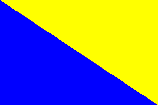
House Flag of Bos & Kalis NV, The Netherlands (fotw)
- PER BEND SINISTER
- 1) A heraldic term used when the division line on a diagonal bicolour, or an object, charge or charges
are placed diagonally from bottom left to top right across the field but see
bend sinister in appendix vi,
in bend sinister and
party).
- 2) In vexillology the term is sometimes used in place of in bend sinister or bendwise
sinister when an object, charge or charges are placed as above - but see
ascending diagonal 2)
(also bicolour 1)).
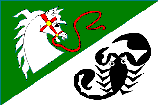
Flag of Nehodνv, Czech Republic (fotw)
- PER CHEVRON
- The heraldic term used when the divisions on a shield or banner of arms, or a series of charges thereon,
appear to form a triangle, sometimes embowed and generally (although not invariably) with the apex upward
but see pile 1) and pile 2)
(also chevron,
embowed,
party and
reversed 2)).





Flag of Alberton, South Africa (fotw); Flag of Neu Wulmstorf, Germany (fotw); Arms and Flag of Koprivnica-Krizevci,
Croatia (fotw); Flag of Seftigen, Switzerland (fotw)
- PER COMPLEMENT
- See moon 2) with following note.
- PER FESS
- 1) In heraldry the term used when a shield or banner of arms is divided
horizontally (see also fess in appendix VI,
in fess and party).
- 2) In vexillology the term is sometimes also used in place of in fess or fesswise when
an object, charge or charges, appear in a horizontal position.


Flag of Medalpad, Sweden (fotw); Arms of Recica ob Savinji, Croatia (fotw)
- PER PALE
- 1) In heraldry the term used when a shield or banner of arms is divided
vertically (see also in pale,
pale in appendix VI and party)
- 2) In vexillology the term is sometimes also used in place of in pale or palewise when an object,
charge or charges, appear in a vertical position.
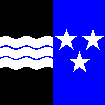
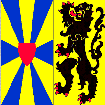
Flag of Argau, Switzerland (fotw); Flag of West Flanders, Belgium (fotw)
- PER SALTIRE
- 1) In heraldry the term used when the division lines on a shield, banner
of arms or flag run in a diagonal fashion from the upper corners - saltirewise
(see also in saltire,
party, and
saltire).
- 2) In vexillology the term is sometimes also used in place of in saltire or saltirewise
when two separate objects or charges cross each other diagonally (see also
orthogonal,).
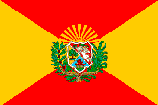
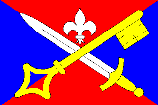 >
>
Flag of Aragua, Venezuela (fotw); Flag of Lubenice, Czech Republic (fotw)
- PERSONAL FLAG
- 1) In UK usage, a fringed plain royal blue flag bearing in its centre a crowned
and garlanded E, and used by HM The Queen when paying official visits abroad
to those countries of which she is not head of state but see note below (also
garland,
monogram and
royal standard).
- 2) See banner 1).
- 3) A flag intended by the designer for his personal use or that of his family
(see also house flag 3)).
- 4) In US naval usage, a term for denoting an officer's rank see flag of
command (also distinguishing flag 3),
individual flag and
rank flag 1)).
Please note that the various flags used by HM The
Queen (of Great Britain) when visiting a Commonwealth country of which she is
head of state are also officially described as personal flags, but must also be
considered as the royal standards of the countries concerned (see also
royal standard and
standard 1)).
|
![[a personal standard]](../images/v/vxt-d241.gif)
Royal Standard of New Zealand (Bartram)
|
![[a personal standard]](../images/v/vxt-d241a.gif)
Personal Flag of HM The Queen, UK (Bartram)
|
- PETRA SANCTA METHOD
- See hatching 1).
- PHOINIKIS
- See semeion.
![[Peace flag]](../images/v/vxt-d239.gif)










 >
>
![[a personal standard]](../images/v/vxt-d241a.gif)





![[a personal standard]](../images/v/vxt-d241.gif)